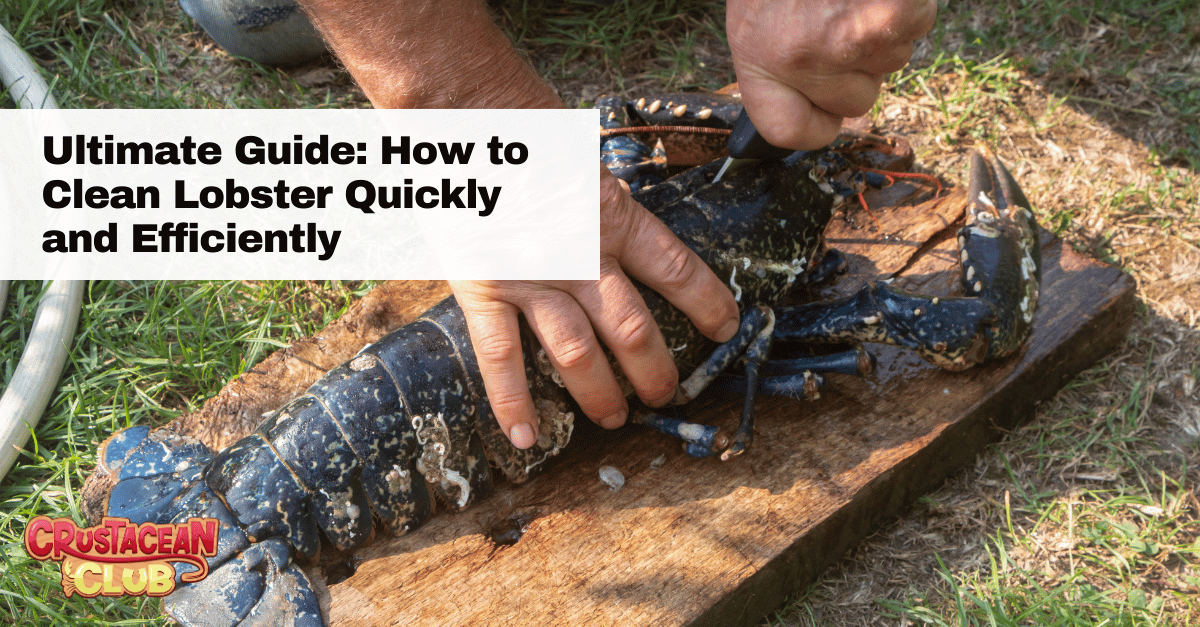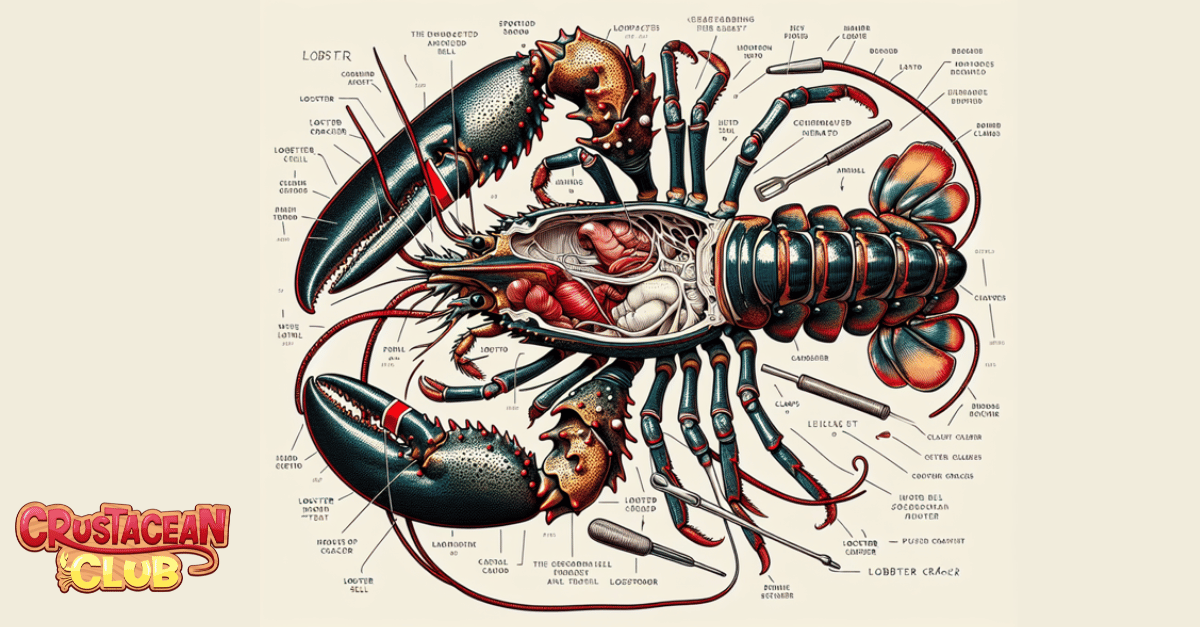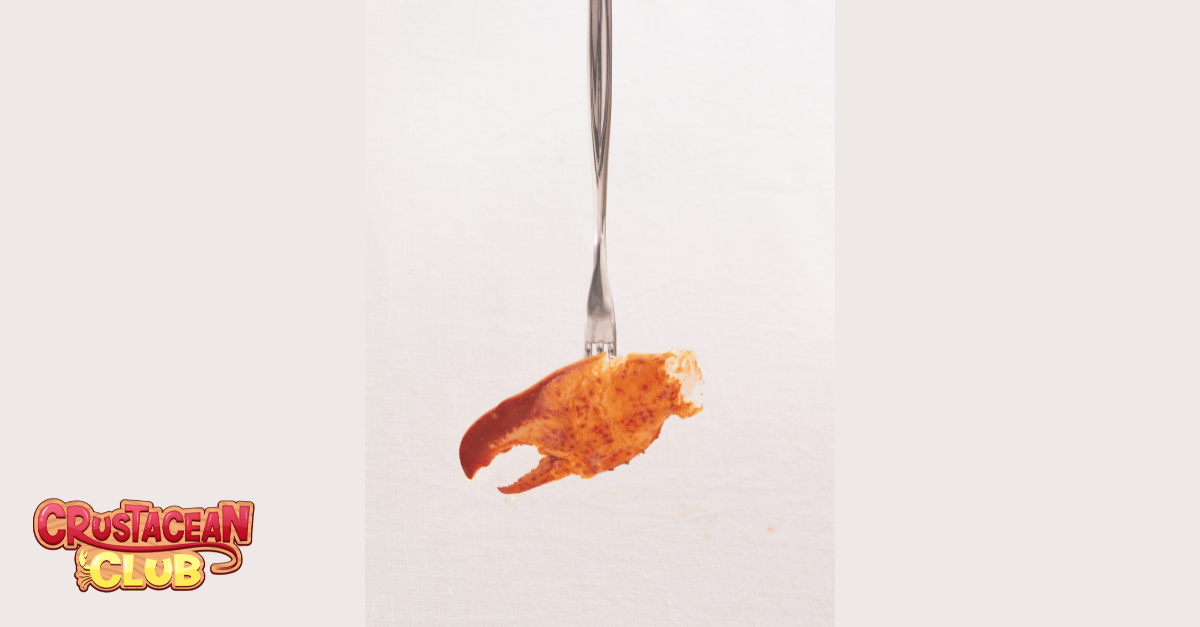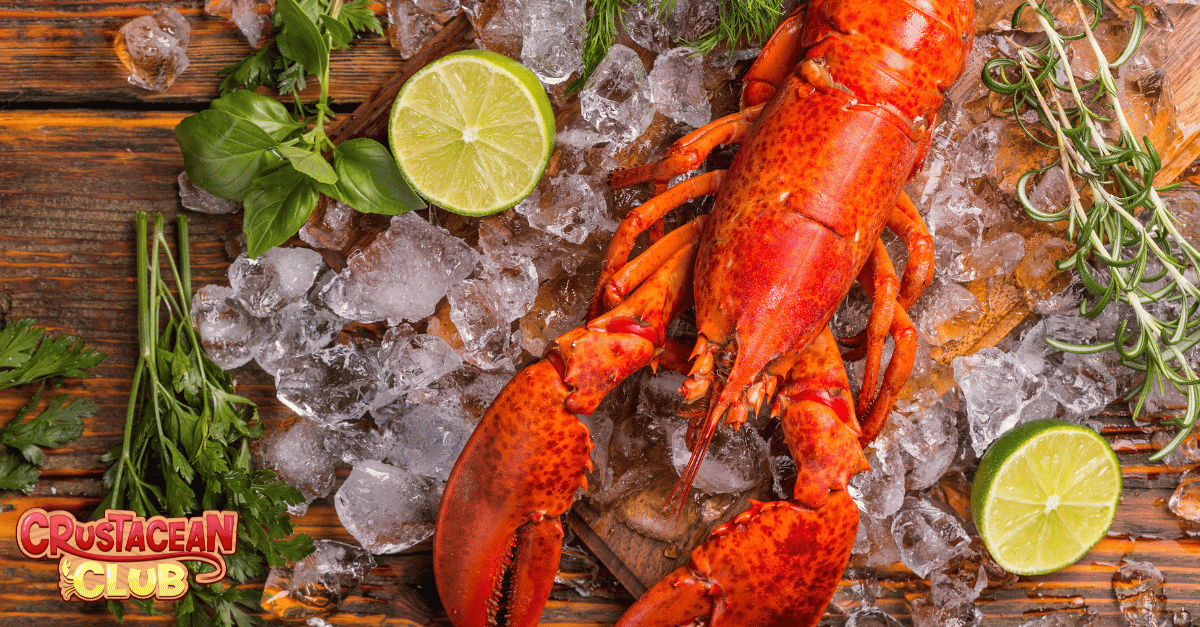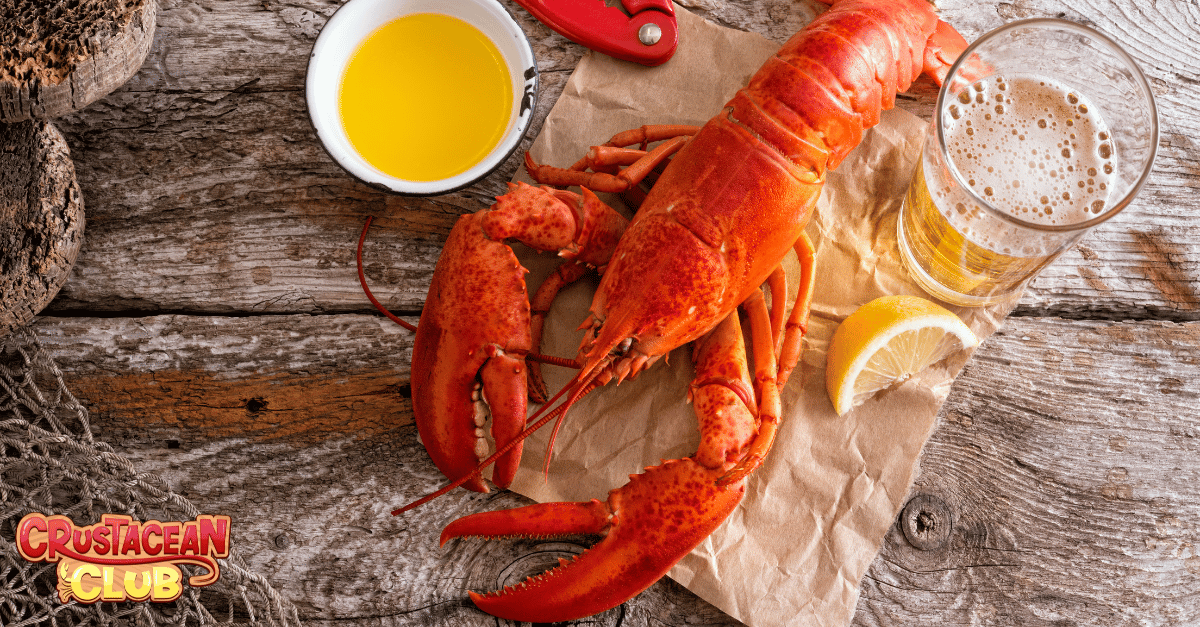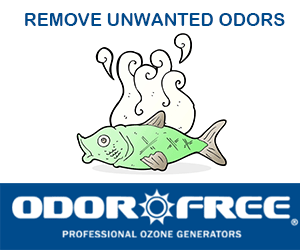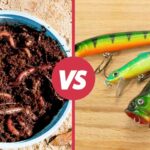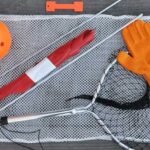Learn how to clean lobster quickly with our straightforward guide. No fluff, just the essential steps to efficiently prepare your lobster for cooking. From removing the vein to dealing with those intimidating claws, we provide the exact techniques needed to turn that whole lobster into prime, cooking-ready meat. Expect to master preparing both live and pre-cooked lobsters in minutes.
Check out the Crustacean Club site for additional information on all things lobster!
Key Takeaways
- Butterflying lobster tails involves using kitchen shears to cut through the shell and is key for both cooking and presentation. Learn more about creative ways to cook your lobster by visiting our library of recipes.
- Always keep lobster claws tied until cooked to prevent injury, and tools like lobster crackers and picks are crucial to extracting the meat without damaging it.
- Choose the right type of lobster (soft shell for a unique experience or hard shell for more meat), use proper storage methods to maintain freshness, and have the right cleaning tools ready to make the process easier.
We love hearing from our readers and subscribers, so please feel free to reach out and contact us today!
Understanding Lobster Anatomy for Proper Cleaning
When it comes to cleaning lobsters, the meaty claws and succulent tail are the key parts to focus on. The lobster tail is usually easier to clean due to its less complex structure. It’s like a treasure trove waiting to be revealed, filled with delicious lobster tail meat.
If you’re wondering how to prepare lobster tails for cooking, kitchen shears are your best friend. They can efficiently cut through the hard shell, allowing you to access the meat. An optional step is to trim the fins, but it’s not necessary unless you’re looking for a more refined presentation.
Now, when it comes to the real deal – butterflying a lobster tail – it’s all about technique. This involves partially splitting the meat while cutting through the hard shell. This not only prepares it for cooking but also elevates the presentation of your cooked lobster.
Ensure a savory catch by learning about the common lobstering locations in Florida by visiting the Crustacean Club’s Hot Spot Locations list!
Preparing Live Lobster for Cleaning
Keep in mind, live lobsters demand careful handling due to their powerful claws. These claws bring a whole new meaning to the phrase, “handle with care.” So, to avoid any unwanted injuries, it’s best to keep the lobster claws bound with rubber bands until the lobster is cooked and safe to handle.
Once the lobster is cooked, you can handle the claws without worrying about getting pinched. At this point, you’re ready to start extracting the delicious lobster meat from the claws and tail, transforming this raw lobster into a culinary masterpiece.
Step-by-Step Guide: Cleaning Your Lobster Before Cooking
With your live lobster cooked safely, it’s now time to prepare it for the main event – the cooking! This involves:
- Rinsing the lobster tails under cold running water
- Removing the dark vein running from the lobster’s body to the tail
- Segmenting the meat with kitchen shears
This method guarantees a properly cleaning lobster, set for the subsequent steps to cook lobster in your preferred cooking style.
Learn more about everything lobster, from catching to cleaning and storing, in our expert guides!
Removing the Head and Tail Shell
First up is separating the lobster’s body from the tail. This involves a gentle twist in opposite directions until they detach. However, it’s crucial to do this carefully to avoid damaging the tail meat. Imagine it like a delicate dance, where both partners need to move in harmony to ensure a successful performance.
Executing this technique results in a neatly detached tail, with undamaged tasty meat primed for further cleaning and cooking. Now, that’s one step closer to your delicious lobster feast! Learn how to cook lobster tails and enjoy a gourmet meal at home with our incredible recipes.
Extracting the Claw Meat
Proceeding to the lobster claws is the next move. Start by laying the cooked lobster on a cutting board and twisting off the claws. Then, it’s time to bring out the heavy artillery – a lobster cracker. This tool can break the claws into sections without crushing the meat, which is key to maintaining the integrity of your tasty lobster meat.
To extract the claw meat, you can either use a lobster pick or fork, or pull the claw at its hinge backwards until the shell breaks, allowing you to gently slide out the meat. For smaller parts like lobster legs, a rolling pin or a wine bottle can be used to gently roll out the meat. That’s a neat little trick to ensure no tasty morsels get left behind!
Dealing with the Remaining Meat
Once the tail and claw meat is extracted, focus on the leftover meat in other areas of the lobster. To retrieve meat from lobster legs, twist them off, flatten with the back of a knife to crack the shell, and then use a pick or the end of a teaspoon to remove the flesh within.
Using tools like seafood forks and lobster picks can also be beneficial to access and remove meat from the lobster’s knuckles and other challenging parts where fingers can’t reach. This ensures that no part of the lobster goes to waste, which is not only efficient but also pays respect to this magnificent creature by utilizing all of it.
Post-Cooking Cleanup: How to Handle Cooked Lobster
Once the lobster is cooked, there’s still work to be done. Here’s how to extract the lobster meat:
- Start by cooling the lobsters in a large bowl to contain the shells during the cleanup process.
- Twist the tail back and forth, remove the tail flippers.
- Twist off the claws, break off the pincher.
- Use a nutcracker or your hands to open the claws.
- A fork can be used to pick the claw and tail meat.
- Meat from the legs can be extracted by pressing with a rolling pin.
Cleaning the interior of the lobster is the next step. Here’s how to do it:
- Split the body in half along its length.
- Use the back of a spoon to remove and discard the stomach sac, gills, and intestinal thread.
- The liver and any roe can be saved for those who choose to consume it.
One of the great things about cooking lobster is that nothing goes to waste. The cleaned empty shells of the lobster can be used to create a flavorful stock, which can be used in recipes like bisque or bouillabaisse. Now that’s what we call a full-circle culinary experience!
Selecting the Best Lobster for Cleaning and Cooking
Selecting the appropriate lobster is as vital as understanding how to clean and cook it. Lobsters go through a growth phase that requires molting their exoskeleton periodically to accommodate their larger size. This results in two types of lobsters – soft shell and hard shell.
Soft shell lobsters, recently molted, have a higher water content and softer texture, which may result in a higher price for less meat. They also have a brighter red color after cooking, which can be visually appealing. In comparison, hard shell lobster offers a firmer texture and more meat per pound, making fresh lobster a popular choice for many seafood lovers. When it comes to soft shell lobster, it’s all about personal preference and the unique culinary experience it provides.
On the other hand, hard shell lobsters offer a firmer meat with a sweet flavor and a more desirable meat to shell ratio, making them a better value. These are commonly found in spring and late fall and can be an excellent choice for those seeking the best lobster for their culinary creations.
Learn and master how to cook a spiny lobster tail with our expert guide!
Preserving Freshness: Storing Uncooked and Leftover Meat
Upon choosing your ideal lobster, it’s essential to be aware of proper storage methods. Live lobsters should be stored in the refrigerator in a breathable container with damp newspaper or seaweed and consumed within 1-2 days. This ensures that your lobster stays fresh until it’s time to clean and cook it.
For storing cooked lobster, place it in an airtight container in the refrigerator, ensuring the temperature stays between 32°F (0°C) and 40°F (4°C). This keeps the lobster meat fresh and ready for your next culinary adventure.
Leftover cooked lobster can be frozen to maintain its freshness. Wrap it in plastic wrap or aluminum foil, then place it in an airtight container before storing it in the freezer. That way, you’ll always have tasty lobster meat on hand for your favorite recipes.
The Right Tools for the Job
With the correct tools, cleaning and cooking lobster becomes a breeze. Kitchen shears are recommended for cutting through the hard shell of the lobster tail to access the meat. Think of them as your trusty sidekick in this culinary adventure.
Another indispensable tool in your lobster cooking venture is a lobster or crab pick. It’s vital for removing small pockets of meat from the legs and body that are difficult to reach. Combine these with a cutting board and a shallow pan to manage the lobster and capture any escaping juices during cleaning.
And don’t forget the humble paper towel! A plentiful supply of these is handy for clean-up and protection from lobster juices. Having the correct tools not only makes the lobster cleaning process more efficient but also ensures that all the meat is used and the process is tidy.
Summary
Cleaning and cooking lobster may seem daunting, but with the right knowledge and tools, it can be a fun and rewarding experience. From understanding the lobster’s anatomy to choosing the right tools and techniques, we’ve walked through each step of the process. We’ve learned how to handle live lobsters safely, the importance of selecting the best lobster for cleaning and cooking, and even how to store uncooked and leftover meat to preserve its freshness.
Now it’s your turn to take this knowledge, roll up your sleeves, and dive into the world of lobster cooking. Don’t be afraid to get your hands dirty (or a little bit buttery). Remember, confidence is the key ingredient in any kitchen!
Learn more about us and the wealth of knowledge we have to offer here at Crustacean Club about all things, well, crustacean!
Frequently Asked Questions
What parts of the lobster should I focus on when cleaning?
Focus on cleaning the claws and tail of the lobster, as they contain the most meat. Happy cooking!
How can I safely handle a live lobster?
To safely handle a live lobster, it’s best to keep its claws bound with rubber bands to prevent any accidents or injuries. Once the lobster is cooked, the bands can be removed before handling.
How can I extract the meat from the lobster claws?
To extract the meat from lobster claws, simply use a lobster cracker to break the claws into sections, then use a lobster pick or fork to remove the meat. Enjoy your meal!
How should I store live lobsters?
Store live lobsters in the refrigerator in a breathable container with damp newspaper or seaweed and consume within 1-2 days for the best freshness.
What’s the difference between soft shell and hard shell lobsters?
Basically, soft shell lobsters have softer meat and more water content, while hard shell lobsters have firmer meat, a sweet flavor, and a better meat to shell ratio. So, it’s a matter of texture and taste preference.
Hi! My name is Jessica, and I am the Head of Content for Crustacean Club. If you woul like any changes or if you want to submit a blog, DM me!

